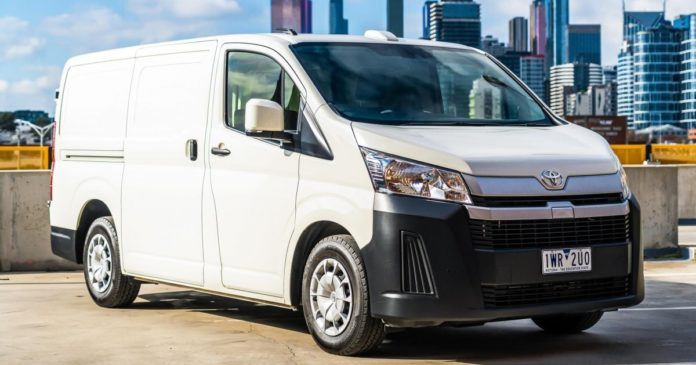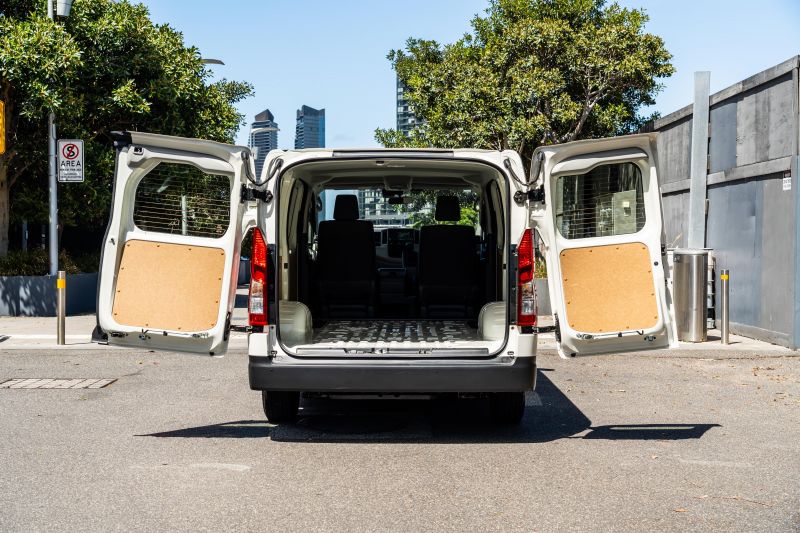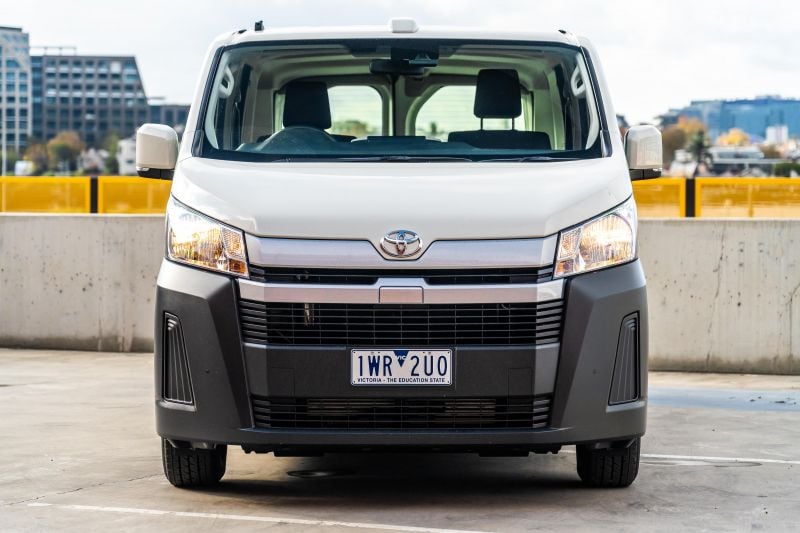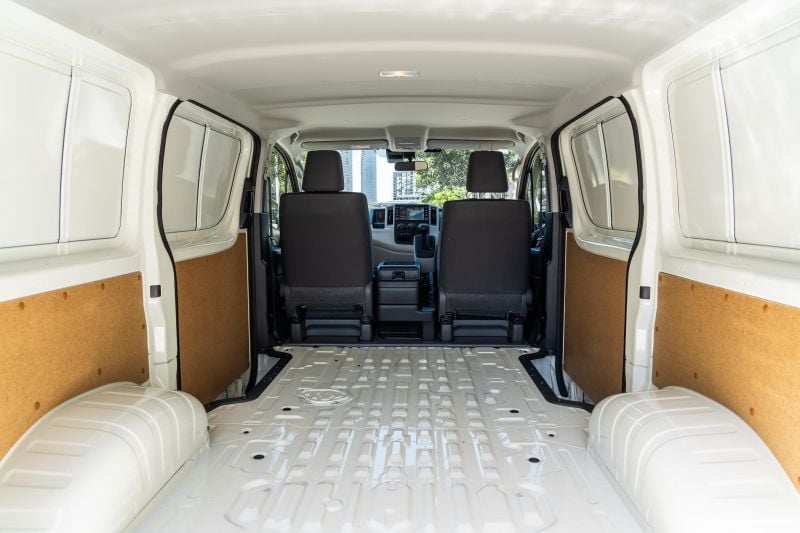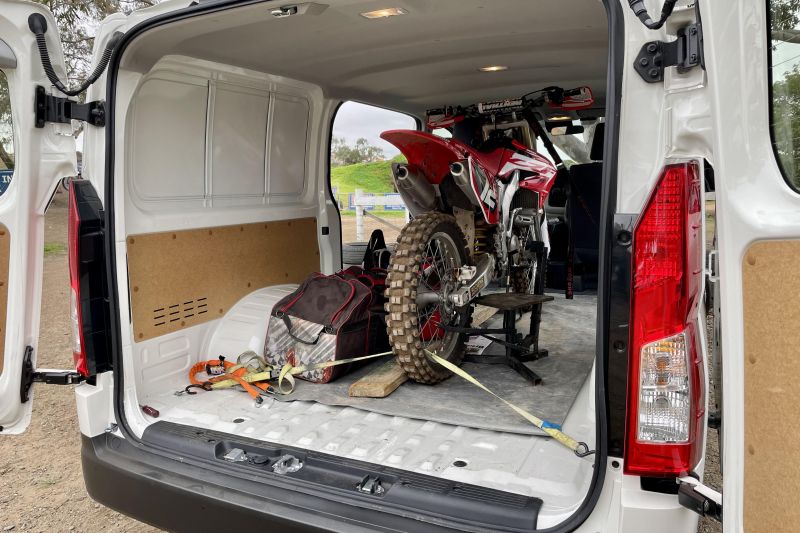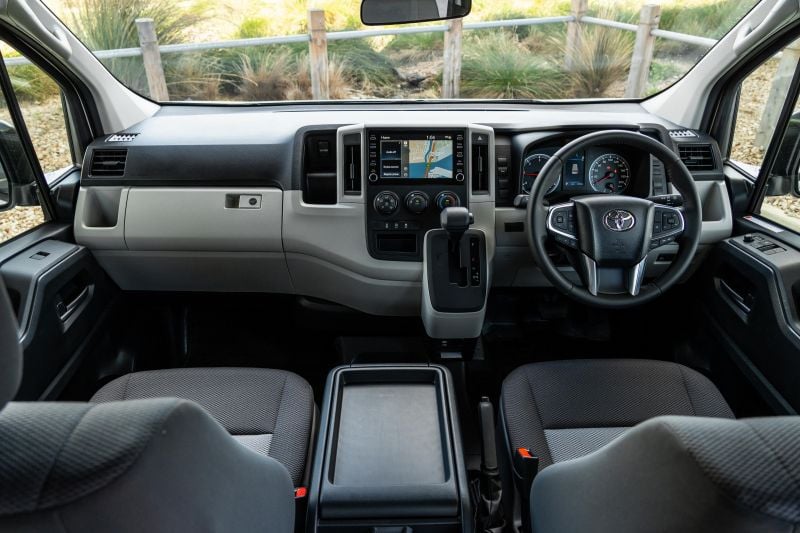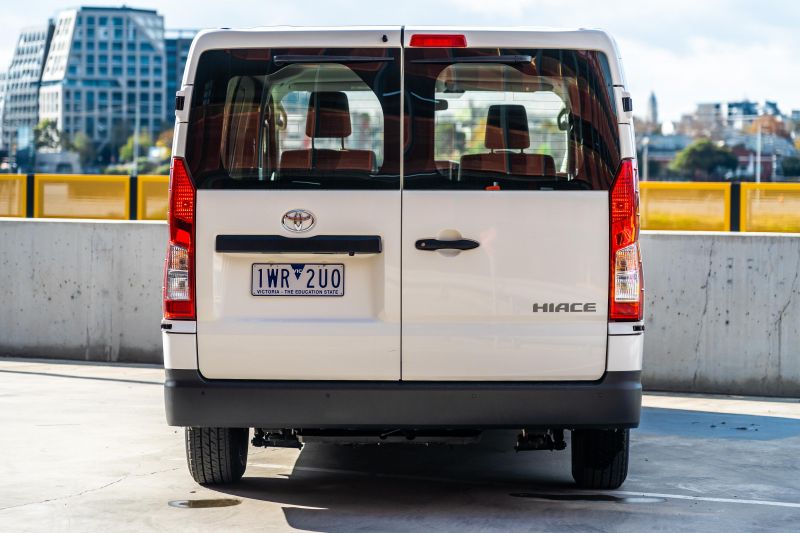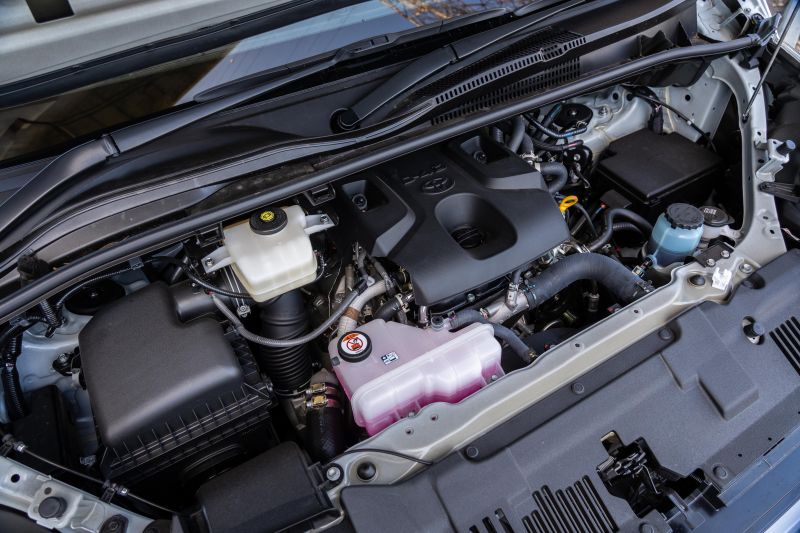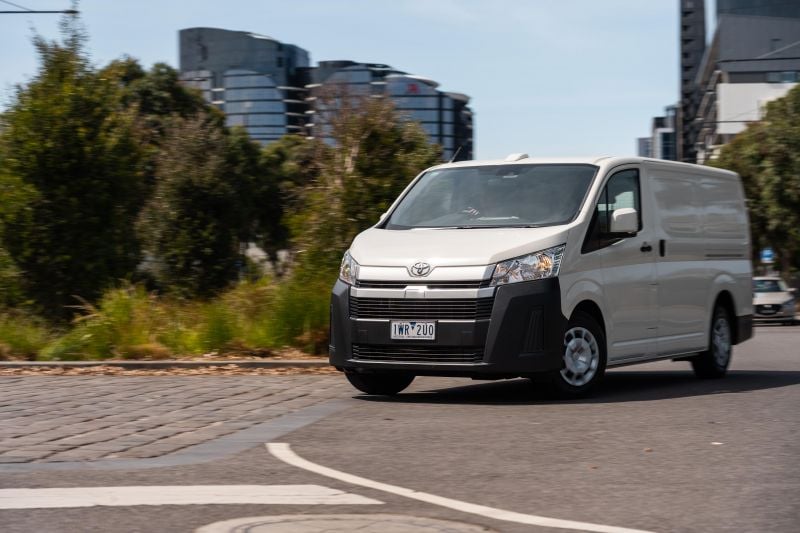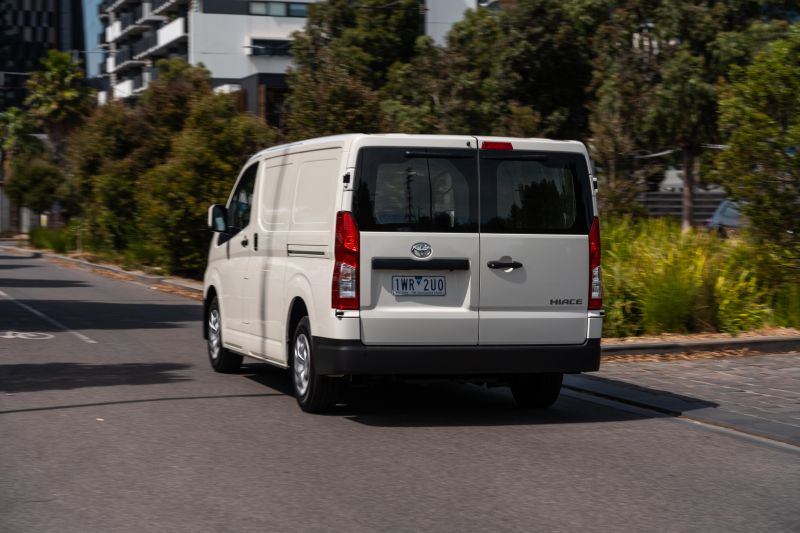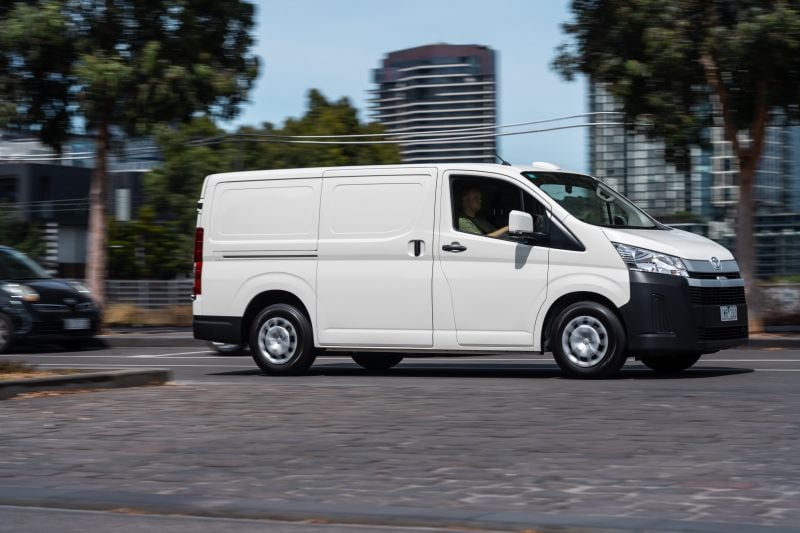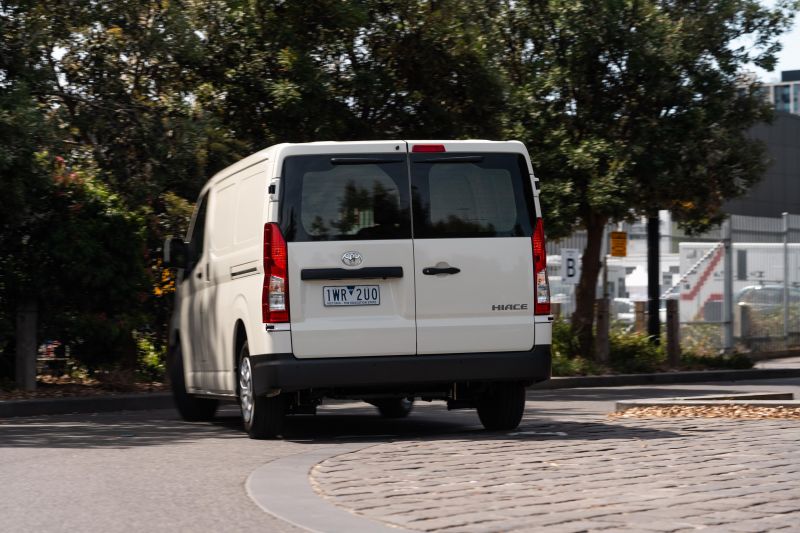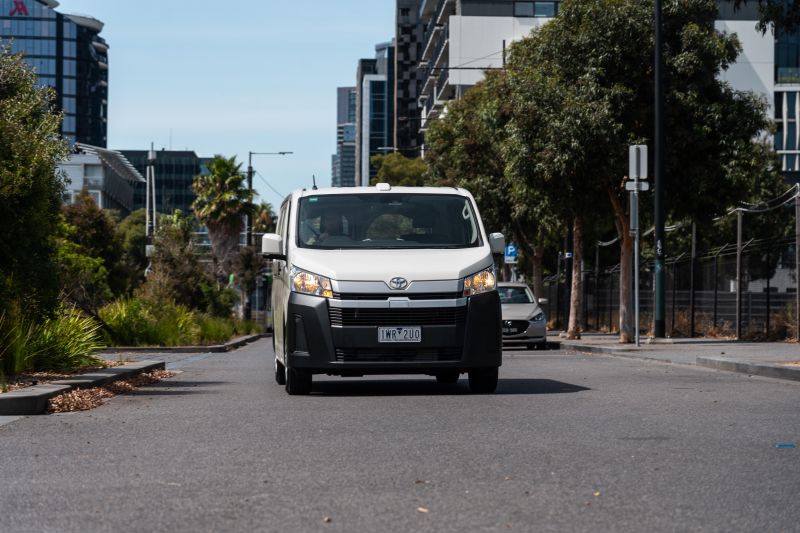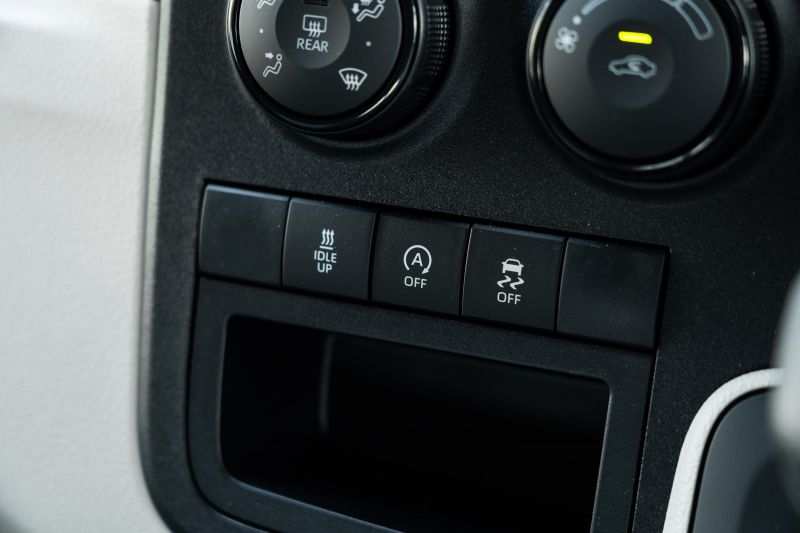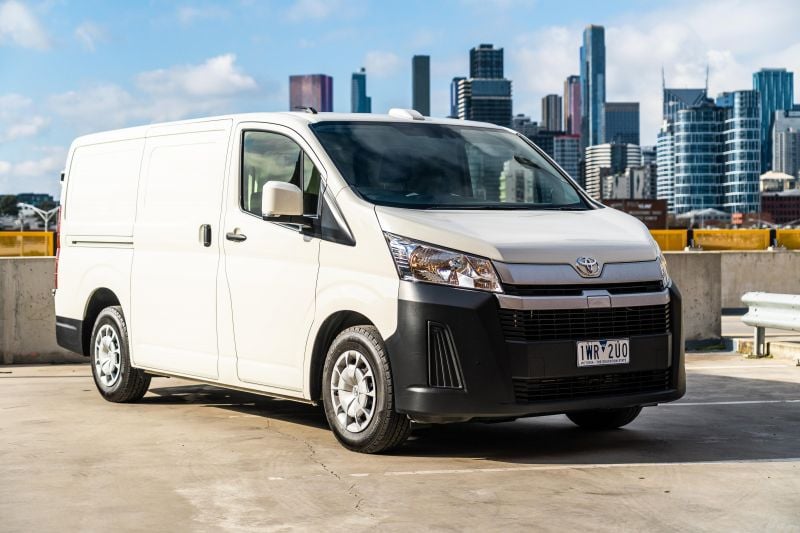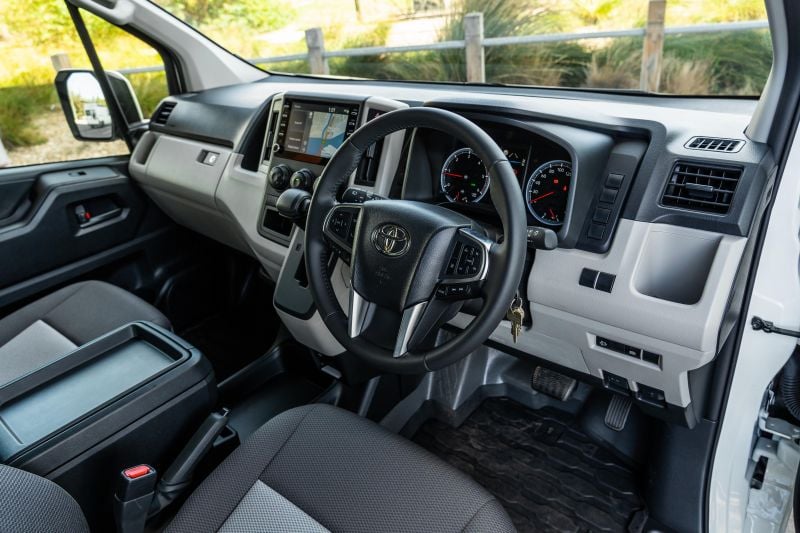The best-selling mid-sized van in Australia needs no introduction – it’s a staple in the segment, and it wears an all-too-familiar badge.
The Toyota HiAce has existed for a very long time, though this barn door version only last year made its return after an absence of nearly 20 years. It’s a welcome addition, bringing extra usability to the already versatile Toyota van range.
It added a fourth year to its streak as best-selling mid-sized van in Australia in 2023, in which time 7133 units were sold to claim a 35.3 per cent share of its market. That’s around 2.0 per cent down on its slice the previous year, but it doesn’t mean the HiAce is struggling.
The next highest-selling vans in its segment were the LDV G10 (3638 units), Ford Transit Custom (2843 units), and Hyundai Staria Load (2497 units), but they’re some way behind the Toyota.
On test here is the Toyota HiAce LWB Barn Door Panel Van, which hasn’t changed at all for 2024. It still has its turbo-diesel powerplant and is available in any colour you want, so long as it’s French Vanilla.
It’s a tried and tested formula, and Toyota has rightfully stuck by its guns once again. You know what they say – if it ain’t broke…
How does the Toyota HiAce compare?
View a detailed breakdown of the Toyota HiAce against similarly sized vehicles.

Toyota
HiAce
How much does the Toyota HiAce cost?
The HiAce van is available with a choice of either a single tailgate or a pair of vertically split barn doors. The barn doors will set you back an extra $750, which means our tester is priced at $49,110 before on-roads.
| HiAce Van | $RRP |
|---|---|
| Toyota HiAce LWB Van 6MT | $46,360 |
| Toyota HiAce LWB Van 6AT | $48,360 |
| Toyota HiAce LWB Panel Van 6AT | $48,360 |
| Toyota HiAce LWB GL Van 6AT | $49,360 |
| Toyota HiAce LWB Crew Van 6AT | $51,360 |
| Toyota HiAce SLWB Van 6AT | $56,920 |
| HiAce Barn Door | $RRP |
|---|---|
| Toyota HiAce LWB Barn Door Van 6AT | $49,110 |
| Toyota HiAce LWB Barn Door Panel Van 6AT | $49,110 |
| Toyota HiAce LWB Barn Door GL Van 6AT | $50,110 |
| Toyota HiAce SLWB Barn Door Van 6AT | $57,670 |
| HiAce Commuter | $RRP |
|---|---|
| Toyota HiAce SLWB Commuter Bus 6AT | $73,560 |
| Toyota HiAce SLWB Commuter GL Bus 6AT | $76,560 |
To see how the HiAce stacks up against its rivals, use our comparison tool.
What is the Toyota HiAce like on the inside?
It’s a commercial van with sizeable proportions, and the inside reflects what it says on the tin.
Sure, the cargo hold is a bit bare on account of the metal floor and wooden wall panels, but just look at how much space you get – 6.2 cubic metres of usable capacity.
The lack of any upholstery or trim means you don’t have to worry about damaging the interior when loading and unloading the HiAce, but that’s not to say you can’t opt for anything more if you need it.
Owners will no doubt be diving through the accessory catalogue to kit out the van suit their needs, and Toyota offers a wide range of goodies like an all-weather cargo liner, various cargo barriers, and canvas seat covers.
That makes the HiAce a properly versatile pack mule.
On the floor of the HiAce are six heavy-duty eyelets located at the front, middle, and back of the cargo area. These can be used as tie-down points for things like pallets to stop them sliding into the back of the unprotected seats.
To test its cargo capability we loaded up a full-size dirt bike for a weekend ride and secured it using the eyelets, which the van handled with ease. It’s rated for a 1075kg payload, so the 103kg bike was never going to be an issue.
The wide load floor means you’d definitely be able to fit one or two more bikes with a bit of creative arranging, but the extra space we had in our test allowed us to throw in a large gear bag, tools, and extra equipment with plenty of room to spare.
It’s worth noting there wasn’t a huge amount of space between the ceiling and the bike’s handlebars, so it was necessary to duck down when loading and unloading. Once it was in, there were no fitment issues to speak of.
The inclusion of barn doors on our tester definitely made the process easier, as access is excellent when they’re open to their full 180-degree wingspan.
They’ll happily hold themselves open at 180 degrees, but if you only need them open halfway you’ll have to engage a manual strut on each door. The struts are sturdy, and they reside neatly clipped into the back of each door when not in use.
If you need to access the van from either side, there are full-height sliding doors included across the range. There are side steps incorporated behind each door, though they eat into floor space at the front of the cargo area.
Climbing into the front of the HiAce reveals a driving area that is nicer than you might expect.
In fact, if you didn’t look over your shoulder you might be forgiven for thinking you were in something like a less-equipped version of a late-2000s Prado.
In keeping with the van’s utilitarian construction the cabin is a bit bare, but the cloth seats are comfortable, there’s loads of room all around, and it’s decked out in durable hard plastic with protective rubber floor mats to boot.
Much like a late-2000s Prado you get a climate control system that’s easily operated by buttons and dials, along with a range of physical controls for the infotainment system and the few driver assist features. There are multiple button blanks scattered around in this spec of HiAce, but they don’t stand out.
The only two screens are for infotainment and vehicle information, the latter of which is placed between two analogue gauges on the instrument cluster. It displays menus which can be scrolled through using buttons on the steering wheel.
The only real downside in here (and it’s a small one) is the infotainment system, which is showing its age. You’ll just have to remember you can only use Apple CarPlay and Android Auto by plugging your phone into the sole USB-A port, located under the gear selector.
It’s still more than functional for the average HiAce owner, and the inclusion of built-in satellite navigation is a nice touch. At least with age comes plenty of time to sort bugs, and the whole system worked flawlessly during our week with the car.
Elsewhere, there are practical storage options like a large glovebox and centre console bin, and five cupholders all up – three on the dashboard and two on the back of the centre console.
There are also two large, flat surfaces in the middle of the cabin, which are perfect for storing paperwork and devices for quick access on the move. It’s all laid out logically and makes sense in the context of a work van.
| Dimensions | Toyota HiAce LWB Barn Door |
|---|---|
| Length | 5265mm |
| Width | 1950mm |
| Height | 1990mm |
| Wheelbase | 3120mm |
| Cargo bay length | 2530mm |
| Cargo bay width | 1760mm (1268mm between wheel arches) |
| Cargo bay height | 1340mm |
| Cargo bay volume | 6.2m3 |
| Payload | 1075kg |
| Kerb weight | 2200kg |
| Gross Vehicle Mass (GVM) | 3300kg |
| Towing capacity | 1500kg (braked) |
To see how the HiAce stacks up against its rivals, use our comparison tool.
What’s under the bonnet?
The HiAce is powered by a 2.8-litre four-cylinder turbo-diesel. Most of the range is fitted with a six-speed automatic transmission, while a six-speed manual is available on only the cheapest variant.
Our tested fuel economy was more than 2.0 litres worse than Toyota’s claim, even with primarily highway driving over the course of our week with the van.
| Toyota HiAce LWB Barn Door | |
|---|---|
| Engine | 2.8L 4cyl turbo-diesel |
| Power | 130kW @ 3400rpm |
| Torque | 450Nm @ 1600rpm – 2400rpm |
| Transmission | 6-speed automatic |
| Driven wheels | Rear-wheel drive |
| Kerb weight | 2245kg |
| Fuel economy – claimed | 8.0L/100km |
| Fuel economy – as tested | 10.1L/100km |
| Fuel tank size | 70L |
| Fuel requirement | Diesel |
To see how the HiAce stacks up against its rivals, use our comparison tool.
How does the Toyota HiAce drive?
Our tester was a bog-standard HiAce with no accessories, so it was a bit like driving around in an empty oil barrel.
While spacious, the cavernous cargo area with its metal floor, metal walls, and wood panelling is echoey on the move and allows road and driveline noise to make its way inside.
Realistically though, it’d be unreasonable to expect this van to be any other way. It’s built for a purpose, and it serves that purpose very well exactly the way it is.
The on-road experience has even been improved over previous generations, which used to seat occupants on top of the loud engine compartment. That’s not the case anymore, as the engine has been moved forward and out of the cabin area underneath a short bonnet.
That bonnet also means the HiAce is now safer than it’s ever been, as there’s more metal between your knees and whatever you might hit. It does come at the expense of front visibility in tight spaces, but I’d argue that’s of negligible impact if it means you’re more likely to walk away from an accident.
Sideways visibility is compromised in this spec of HiAce, as a lack of windows on the sliding doors means you can’t see anything over your shoulder if you want to do a head-check. It does come with blind-spot monitoring as standard, but it can be a little unnerving to rely solely on that function when switching lanes on the freeway.
Rear windows are included on Crew Van and Commuter variants, though they’re geared towards transporting passengers in contrast to the standard LWB van’s cargo focus.
Without all the interior gear and extra glass, our tester is one of the lightest variants of the whole HiAce range. That means its turbo-diesel engine has no issues getting up to speed.
It produces plenty of torque low in the rev range, and doesn’t complain if you need to set off in a rush.
Give it some throttle at a standstill and you’ll notice how it picks up speed effortlessly, especially unladen. Even with a load, it certainly doesn’t hang around as it muscles its way through the rev range.
The HiAce shares its turbo-diesel engine with the HiLux ute, but it gains a convenient engine stop/start function that helps to save fuel if you’re spending a lot of time at a standstill. If you don’t want to bother with that, there’s a button beneath the climate controls to switch it off.
Motoring along in the HiAce proves to be a comfortable experience, as the engine and transmission combination is buttery smooth for a commercial van.
The six-speed gearbox means you’ll have plenty to work with at low speed, while it allows the engine to tick along at low revs on the highway – both saving fuel and minimising the diesel chatter entering in the cabin.
Its long wheelbase and wide stance makes it feel planted on the road, which along with the solid and direct steering makes it easy to drive. If you’re used to a normal passenger car, it won’t take you long to feel comfortable behind the wheel of the HiAce.
In addition to the blind-spot monitoring function, it includes large side mirrors and rear windows on its barn doors for added visibility. Though it lacks adaptive cruise control, the standard cruise function makes it a breeze to chug along on the highway.
It’s no question the HiAce is a big vehicle given it’s nearly two metres wide, but it rarely feels like it’s too big.
There’s a lane-keep assist system to catch you if you drift out of your lane, though instead of gently steering you back on track it’ll grab your attention by applying the brakes. It’s not the end of the world but it will catch you out, especially if you’re on a narrower regional road and need to avoid something like a pothole.
To top it all off the HiAce is surprisingly manoeuvrable, with light steering at low speed and that high seating position making it easy to place in tight spaces.
It has a solid turning circle too, and the reversing camera makes it easy to back into a parking spot or up to a trailer. All in all it’s about as fit for the job as anyone could ever ask it to be.
What do you get?
All HiAce models seat two occupants, except the Crew Van which seats five and the Commuter which seats 12.
While opting for the barn doors comes at a premium, you do get improved access to the HiAce’s cargo hold and a rear wiper for each door on LWB models.
The HiAce comes standard with the following features:
- 16-inch steel wheels
- Full-size spare wheel
- 8.0-inch touchscreen infotainment system
- Wired Apple CarPlay, Android Auto
- Bluetooth
- DAB+ digital radio
- Satellite navigation
- 4.2-inch instrument cluster display screen
- Front USB port
- Cruise control
- Leather-accented steering wheel
- Driver powered lumbar support
Is the Toyota HiAce safe?
The HiAce wears a five-star ANCAP safety rating based on testing conducted in 2019.
It scored 94 per cent for adult occupant protection, 88 per cent for child occupant protection, 84 per cent for vulnerable road user protection, and 77 per cent for safety assist.
Standard safety equipment includes:
- Autonomous emergency braking (AEB)
- Pedestrian detection (day/night)
- Cyclist detection (day)
- Blind-spot monitoring
- Lane departure warning
- Lane keep assist
- Rear cross-traffic alert
- Automatic high-beam
- Traffic sign recognition
- Reversing camera
- Front and rear parking sensors
Most of the HiAce range, including our tester, has seven airbags. The exceptions are the LWB Crew Van, which has nine, and the Commuter, which has three.
The range received Toyota Connected Services in 2022, which includes 24/7 Emergency Call Centre function that relays the vehicle’s location in the event of a collision.
That function will activate if the vehicle is involved in a collision “that requires intervention”, or if an airbag deploys. Alternatively, it can be triggered manually via an SOS button located on the cabin’s ceiling.
How much does the Toyota HiAce cost to run?
As with the wider Toyota range, the HiAce is backed by a five-year, unlimited-kilometre warranty.
That warranty extends to seven years on the drivetrain if you service your HiAce on time and within the Toyota dealer network.
Capped-price servicing is offered for the for six services, which are required every six months or 10,000 kilometres, whichever comes first.
Those service intervals might be a touch short for people who might rely the HiAce for work purposes, but at least they’re kept easy on the wallet at $260 each.
CarExpert’s Take on the Toyota HiAce
Unsurprisingly for the omnipresent Toyota brand, its HiAce is an excellent choice for a commercial work van.
There are loads of different variants and body configurations to suit your individual needs, and if that isn’t enough there’s plenty of personalisation to be done via the accessory catalogues.
Even without extra bits and bobs added, on the HiAce does a good job keeping the driver comfortable while keeping plenty of space for all sorts of cargo in the back. It might be a bit bare in this trim level, but there’s no questioning its practicality.
The option of barn doors is an added bonus. If you’re going to be utilising loading docks or lifting in cargo with a forklift it’s the obvious choice for ease of access.
The barn door HiAce works especially well in its specific Panel Van variant too, as you don’t have to worry about damaging the interior during commercial use.
The beauty of the HiAce lineup is its sheer scope of applications, as there’s almost always going to be an option that’ll suit you and your needs.
Combined with the very capable range-standard turbo-diesel engine, Toyota’s van staple will almost certainly have you covered in one way or another.
A benefit would definitely be an upgraded infotainment system, but you’ll hardly wrong if you’re someone who prefers to keep your phone hooked up to CarPlay or Android Auto. It could also do with longer service intervals, as less time spent at the dealer means less work disruptions.
Regardless, if you’re in the market for a capable van, the HiAce is still a wise addition to the wish list.
Click the images for the full gallery
MORE: Buy a Toyota HiAce
MORE: Everything Toyota HiAce

